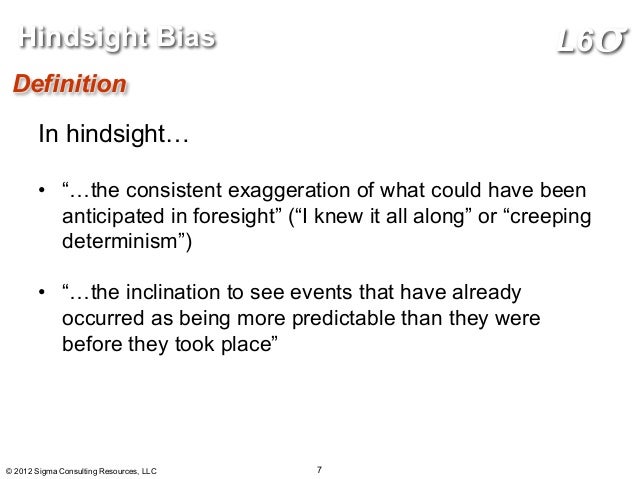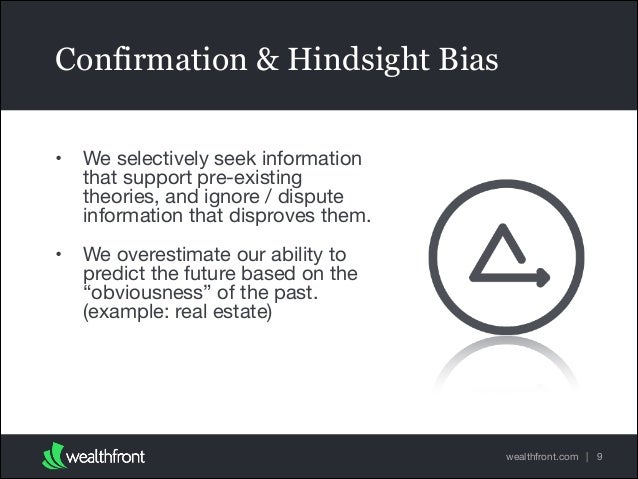

We report effect sizes as point-biserial correlations ( r 2) in order to circumvent the problems associated with heterogeneity of variance and unequal sample sizes. There was less variability in naïve identification than in hindsight estimates therefore, we report analyses assuming either equal or unequal variance, accordingly. Table 1 lists the mean naïve-identification rates (i.e., the percentages of words correctly identified) and the mean hindsight estimations for all experiments.
Hindsight bias psychology definition portable#
We tested the participants in groups and presented the stimuli via a portable stereo. Pilot work indicated that the two tasks required different amounts of time, hence the different time limits. Participants had approximately 4.5 s to respond. Again, the interitem interval was 12 s, with the clear word presented at 1.5 s and the degraded word presented 5.5 s after tone onset. Unlike traditional hindsight bias studies, which involve judgments about one’s own ability to foresee outcomes while ignoring outcome knowledge, here we asked participants to ignore outcome knowledge while estimating what percentage of their naïve peers would correctly identify the degraded word when their peers had not heard the clear word first. The clear word is the functional equivalent of the outcome knowledge in more traditional hindsight bias studies. In the hindsight estimation task, the 0.5 s warning tone preceded a clear word, followed by a degraded version of the word. The interitem interval between tones was 12 s, leaving participants approximately 8.5 s to write down the word.

For each trial, a 0.5 s warning tone preceded the degraded word, presented 1.5 s after tone onset. In the naïve-identification task, participants tried to identify degraded words (see the Electronic Supplementary Material for the words and the instructions). We counterbalanced block presentation order (Block 1 first, Block 2 first) and task order (naïve identification first, hindsight estimation first).

We randomly divided the 40 words into two blocks (Block 1 contained Words 1–20 Block 2, Words 21–40), and we fixed the word orders within each block. The experiment had one within-subjects variable (task: naïve identification or hindsight estimation). We recorded the final presentation of the stimuli onto audio CD. The final set of 40 words contained a low-pass filter frequency between 9 Hz. We chose a low identification base rate because hindsight bias tends to increase as task difficulty increases (see Harley et al., 2004). We created 30 levels of degradation, containing cutoff frequencies between 50 Hz, and then investigated these stimuli in a pilot study to find the frequencies at which only 10 %–20 % of participants could identify the degraded words after one hearing. Lowering the cutoff frequency for the low-pass filter makes it harder to identify the degraded word. For this reason, researchers use low-pass filters to simulate high-tone hearing loss in people of normal hearing (Scott, Green, & Stuart, 2001). At a frequency cutoff of 2000 Hz, people with normal hearing begin confusing consonant sounds (Sher & Owens, 1974).

Lowering the filter’s cutoff frequency dampens the higher-frequency sounds associated with consonants in spoken language. Low-pass filters reduce the amplitudes of the sound frequencies above the filter’s cutoff frequency. We recorded 58 common-object words (e.g., “barn”), and degraded each using a low-pass filter in MATLAB. A group of 78 undergraduates (55 female, 23 male mean age 22.7 years) participated in exchange for credit.


 0 kommentar(er)
0 kommentar(er)
